Cookies Glossary: A Glossary Of The Different Cookies TypesPage 4: Terms Beginning With G To H This is Page 4 of an 10-page article. Click on the red links below to visit other pages. This glossary is protected by copyright and cannot be reproduced in whole or part. You are welcome to link to it.
|
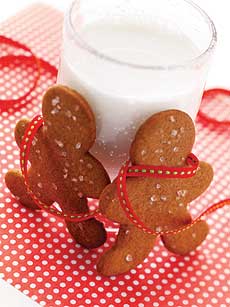 These gingerbread cookies are sprinkled with salt for a sweet-and-salty effect. See the recipe. from the Wisconsin Milk Marketing Board. |
|
| GAUFRETTES: Gaufrettes are delicate, buttery, flaky fan-shaped wafer cookies. They are traditionally served with ice cream, as well as with mousse, hot chocolate, dessert wine and other sweets and beverages. Petticoat shortbread is another fan-shaped cookie, but it is of a hearty, crunchy shortbread texture, compared to gaufrettes. |
 Gaufrettes are available at specialty food stores and Amazon.com. |
|
| GINGERBREAD COOKIE: Gingerbread cookies are examples of rolled cookies. Prior to the 15th century, “gingerbread” referred to preserved ginger. Then ginger was found to have preservative qualities* and it began to be used in cakes and cookies. Crusaders returning from the Middle East brought ginger and other spices; monks made the first gingerbread for holidays and festivals. The spice ginger, zingebar in Latin, became gingerbras in Old French, gingerbread in Medieval English and Ingwer in German. What we call gingerbread cookies are the German spice cookies known as Lebkuchen. Gingerbread cookies are traditionally made in shapes—flowers, hearts, trees and so forth. They vary by size and can be iced and decorated. The Medieval German Lebkuchen Guild transformed gingerbread into a highly-decorated art, crafting fancy shapes, decorated with sugar and gold. But they weren’t making gingerbread men! The honor for that invention probably goes to Queen Elizabeth I—or more precisely, an unnamed palace baker who toiled during her reign (1558 to 1603). Her Majesty bestowed “portrait” gingerbread cookies upon important court visitors, decorated in their likenesses. The tale of Hansel and Gretel, published in 1812 (as part of Grimm’s Fairy Tales), vastly increased the popularity of gingerbread cookies and other treats, such as gingerbread Christmas cards. Gingerbread men and animals became popular Christmas tree ornaments. Today, you can make everything from gingerbread bar cookies to gingerbread whoopie pies to cookies that look like tiny gingerbread houses. _________ |
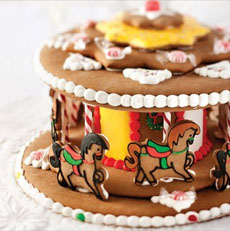 The art of gingerbread, transformed into a 100% edible carousel. Photo courtesy MackenzieLtd.com. |
|
| GINGER COOKIE: A ginger cookie is a soft, molasses-type cookie that is flavored with ginger and other spices. It is larger than, and otherwise differs from, a gingersnap (see below).
|
||
| GINGERSNAP or GINGER SNAP: Unlike the fancier gingerbread, a gingersnap is a small, thin, plain round cookie with a hard, smooth texture like a gingerbread cookie (see above). It is a smaller version of the traditional German Christmas cookie known as Lebkuchen. Like a gingerbread cookie, it breaks with a “snap.” Gingersnaps contain a larger amount of ginger, and thus are spicier, than the chewier ginger cookies. The history of the ginger snap dates back to the Lebkuchen, which were probably invented by Medieval monks in Franconia, Germany. The earliest written records of Lebkuchen baking are 1296 in Ulm and 1395 in Nuremberg. |
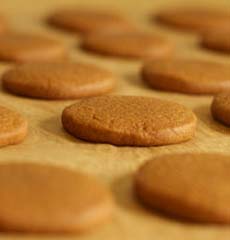 Ginger snaps from Michael Recchiuti. Get the recipe. |
|
| GLAZE: A glaze consisting of powdered sugar, water, corn syrup and flavoring (almond or vanilla, for example) can be used as a cookie icing. This recipe from McCormick makes a half cup of glaze: 1 cup confectioners’ sugar, 3-1/2 teaspoons milk, 1/4 teaspoon vanilla or almond extract, 2 teaspoons light corn syrup and any food color. To prepare, mix sugar, milk and extract in small bowl until smooth. Stir in corn syrup until glaze is smooth and glossy. If glaze is too thick, use a small amount of corn syrup to thin. Stir in 3 to 4 drops food color until evenly distributed and glaze is smooth. Add additional drops of food color until glaze is of desired color. Place cookies on a cooling rack over a foil-lined baking sheet. Holding a cookie by its edge, dip the top of cookie into the glaze or spoon the glaze onto cookies with a teaspoon. Cookies can also be glazed using a new small paintbrush. Place glazed cookies on cooling rack to dry. |
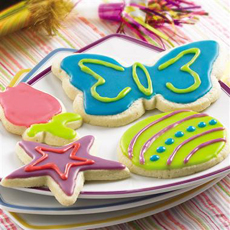 Cookie glaze. Photo courtesy McCormick.com. |
|
| GRAHAM CRACKER: Graham crackers were actually invented to control lust, by The Reverend Sylvester Graham (1794-1851), an eccentric Presbyterian minister from Connecticut. The Reverend believed that physical lust was the cause of maladies, from biggies like consumption, spinal disease, epilepsy and insanity, to everyday indispositions such as headaches and indigestion. His “cure” was to suppress carnal urges, for which he prescribed a strict vegetarian diet and the avoidance of alcohol, tobacco and refined white flour. Toward this latter end, he invented the eponymous graham flour, from which came the graham cracker. Graham flour is a form of whole wheat flour in which the bran and germ layers are returned and mixed in, producing a coarse, brown flour with a nutty and slightly sweet flavor. (Grape Nuts cereal is made from graham flour.) The original graham crackers and artisan-made varieties are delicious. Unfortunately, the large commercial brands are a pallid derivative, with little graham flavor. |
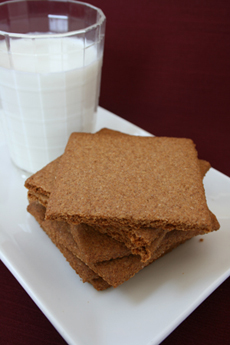 Old-fashioned goodness: Laura’s Handcrafted Graham Crackers, a Top Pick Of The Week. Photography by Hannah Kaminsky | THE NIBBLE. |
|
| HALF MOON COOKIE: In 1920, Harry B. Hemstrought, an architect, opened a small bakery on Genesee Street in Utica, New York. Hemstrought’s Bakery moved to Columbia Street in 1927. Today the retail bakery is combined with the plant at 900 Oswego St. The bakery became famous for the “first ever half moon cookie; and the recipe has not changed since 1920. In fact, the Half Moon as a variation of the Black and White Cookie, which was sold in New York City 20 years or more before Hemstrought’s. Hemstrought’s is still in operation and you can buy the cookies online. |
 Half Moon Cookies. Photo courtesy Sneaks and Sweets. |
|
| GINGER COOKIE: A ginger cookie is a soft, molasses-type cookie that is flavored with ginger and other spices. It is larger than, and otherwise differs from, a gingersnap (see below). |
||
| GINGERSNAP or GINGER SNAP: Unlike the fancier gingerbread, a gingersnap is a small, thin, plain round cookie with a hard, smooth texture like a gingerbread cookie (see above). It is a smaller version of the traditional German Christmas cookie known as Lebkuchen. Like a gingerbread cookie, it breaks with a “snap.” Gingersnaps contain a larger amount of ginger, and thus are spicier, than the chewier ginger cookies. |
 Ginger snaps from Michael Recchiuti. Get the recipe. |
|
| HAMENTASH or HAMENTASCH (PLURAL HAMENTASHEN): A three-cornered filled cookie traditionally eaten during the Jewish holiday of Purim. The name references Haman, an evil 5th Century B.C.E. Persian noble and the villain of the Purim story in the Bible’s Book Of Esther. He wore a tricorner hat; the tricorner shape of the cookie is achieved by folding in the sides of a circular piece of dough, with a filling placed in the center. Traditional fillings are poppy seed, prune, date, apricot, and fruit preserves; modern bakers have made the cookie more popular by substituting chocolate, dulce de leche and sweetened cheese. Depending on the Hebrew calendar, Purim is during late February or early March. At that time, you can order hamantashen online from ExceptionalDesserts.com. |
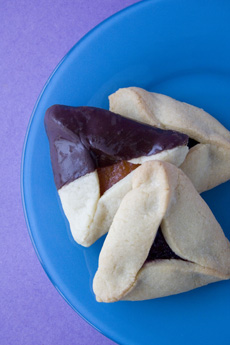 Chocolate-dipped apricot and plain prune hamantashen from TheExceptionalDessert.com. Photo by Claire Freierman | THE NIBBLE. |
|
| HARDTACK or PILOT BISCUIT or SEA BISCUIT: Hardtack, while not a pleasurable food, has been an inexpensive and convenient form of basic sustenance for explorers, pioneers and soldiers as far back as the Roman army. A hard biscuit or cracker that is made only with flour and water, virtually all the moisture is baked away so it can last for years without refrigeration. Hardtack can be dipped into coffee, crumbled into soups and combined with other ingredients at hand. They were the inspiration for dog biscuits (sailors fed the hardtack to their dogs). More pleasurable forms of hard biscuits include biscotti, rusks and zweiback. Go To Next Page: Terms With I To L |
||
Last Updated May 2018
© Copyright 2005-2025 Lifestyle Direct, Inc. All rights reserved. All images are copyrighted to their respective owners.